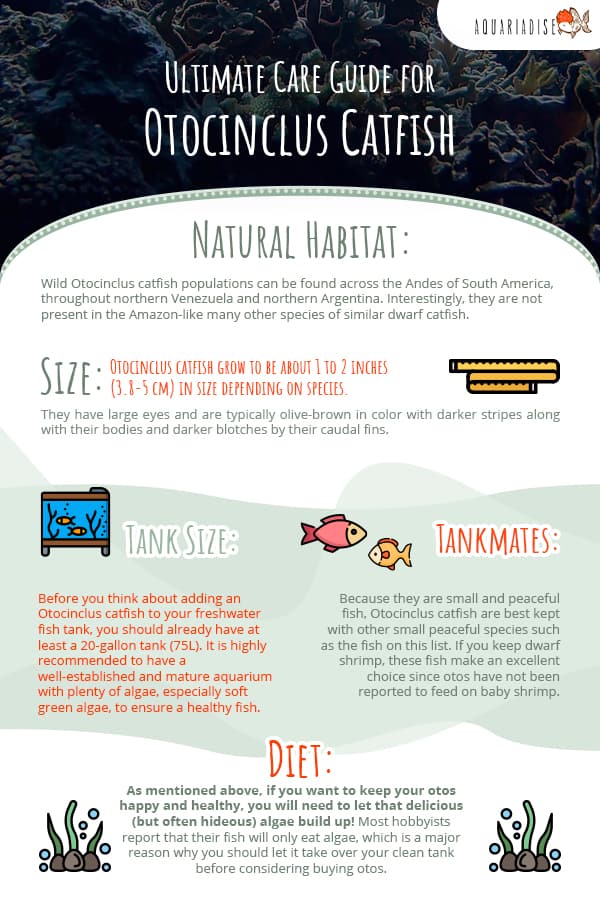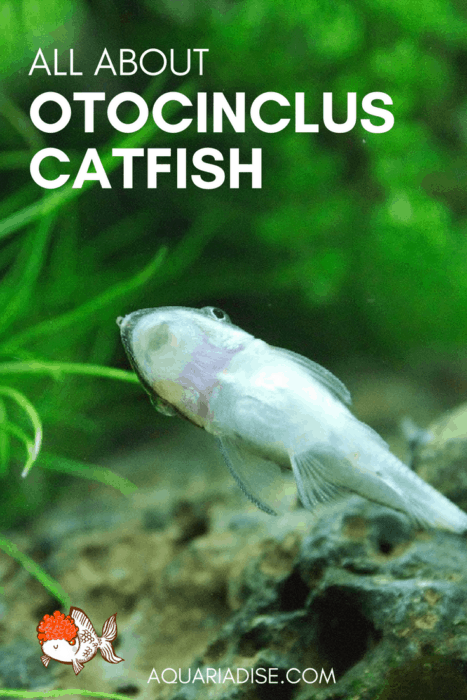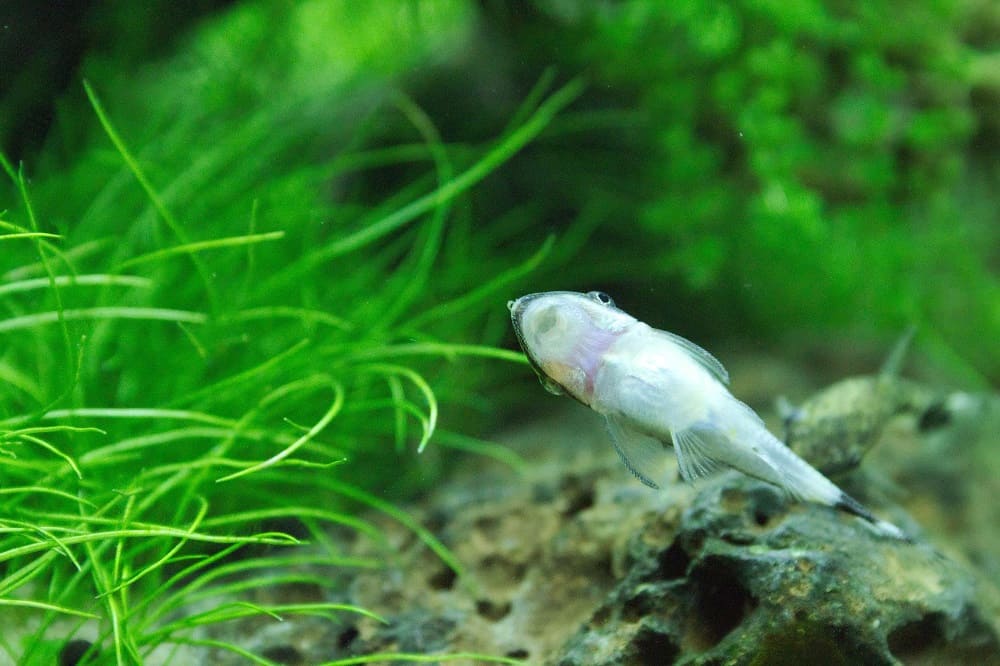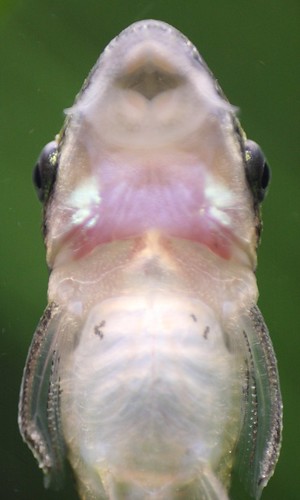Otocinclus are little freshwater fish with a big appetite for algae. This aquascape-favorite seems ideal as an algae cleaner for small aquariums, but these dwarf catfish need some pretty specific care. If you’re willing to provide them with what they need to stay healthy and thriving, you’ll have a fascinating addition to your aquarium!
Keep reading for everything you need to know about keeping Otocinclus catfish care and keeping Otocinclus catfish in your freshwater aquarium.
| Minimum tank size | 20 gal (75 L) |
| Temperament | Peaceful |
| Diet | Herbivore |
| Temperature | 72-81 °F/22-27 °C |
| pH | 6-7.5 |
Name
The Otocinclus genus contains 19 species of freshwater catfish. As a whole, they are often referred to as otos, oto catfish, or dwarf suckers.

Natural Habitat
Wild Otocinclus catfish populations can be found across the Andes of South America, throughout northern Venezuela and northern Argentina. Interestingly, they are not present in the Amazon-like many other species of similar dwarf catfish. In these regions, they live in well-oxygenated water, such as streams and rivers with moderate flow. These fish school on the riverbanks, where the water is calm enough to let them cling to and eat algae off the substrate, rocks, or plants without being carried away.
Otocinclus catfish have adapted the ability to breathe air; this allows them to live in more anoxic freshwater conditions. They can be seen swimming to the surface and returning to the bottom without circulating water through their gills, meaning they are utilizing the air they took in from the top of the water.
Unlike many other types of similar fish, Otocinclus catfish lay their eggs and do not guard them. Other fish of the same family tend to build a nest and stay around the area to protect the eggs and even care for young juveniles.
To help your fish feel more at home in your aquarium, the tank should have a sandy substrate and plenty of plants and wood for hiding in. A powerful filter with lots of media for added beneficial bacteria and strong water flow for aeration is essential oto care.

Identification
The two most common oto catfish species typically found at your local pet stores include Otocinclus macrospilus and Otocinclus vittatus, which look very similar to a beginner’s eyes. Both otos have a greenish-brown back with a cream underbelly, separated by a dark brown lateral bar. While these freshwater catfish definitely look the same at first glance, they can easily be identified if you know what you’re looking for!
- Otocinclus macrospilus has a marbled-pattern bar along its sides that do not reach the caudal fin.
- Otocinclus vittatus has more defined lines that run along the entire length of the body and into the caudal fin.
To make it even more confusing, many stores mislabel and sell both these fish as Otocinclus affinis. While these otos are rare and unlikely to find in the average aquarium store, it’s definitely something to keep in mind!
The most beautiful species is considered to be the Otocinclus cocama, which has dark and light vertical stripes. Given how desirable it is, it’ll also put the biggest dent in your wallet to buy! That being said, if you’re willing to spend the money, it will make for an absolute showstopper in your tank.
How big do Otocinclus catfishget?
Otocinclus catfish grow to be about 1 to 2 inches (3.8-5 cm) in size depending on species. They have large eyes and are typically olive-brown in color with darker stripes along with their bodies and darker blotches by their caudal fins. It is not easy to tell them apart, but female otos tend to be larger and wider than males of the same age.
Oto catfish are often confused with other similar-looking fish in the aquarium hobby, such as Siamese algae eaters, Chinese algae eaters, and Siamese flying foxes. Make sure you know the correct identification of your new pet! You always want to research the exact species you are buying for your tank so you can keep them healthy and provide the care they need.
Otocinclus catfish requirements
Before you think about adding an Otocinclus catfish to your freshwater fish tank, you should already have at least a 20-gallon tank (75L). It is highly recommended to have a well-established and mature aquarium with plenty of algae, especially soft green algae, to ensure a healthy fish. Although we all love sparkling clean aquariums, you’ll have to resist using your algae scrubber since algae will make up much of the diet for your Otocinclus catfish. They don’t care for green spot algae (GSA), although some hobbyists have reported that they may graze on diatoms (brown algae) and other biofilms.
While many people recommend 10-15 oto catfish for a 20-gallon setup, feeding demands will become a problem. This many Otocinclus catfish will eat more green algae than your tank can produce. A group of 4-6 for this tank size should be plenty for your fish to school while ensuring there is enough food for all.
While you may be tempted to fill your tank with fast-growing plants to make quick hiding places, you should stick with slow-growing plants, such as Anubias and Java fern. This will allow algae to grow and provide a natural food source for your fish. It is best to use ceramic tubes as hiding places throughout your aquarium instead. Don’t worry! Your algae eaters will not munch on any of the planted vegetation in your tank.
Many hobbyists warn about how sensitive Otocinclus catfish are when adding them to an aquarium, even under well-established conditions. Their high sensitivity is often attributed to how the fish are captured in the wild since breeding in an aquarium setting is not common. Common practices involve pouring diluted cyanide into their freshwater habitats until they are subdued and easier to catch. While some hobbyists attribute the mass die-offs to this inhumane poisoning, overcrowding, and poor water parameters, others think that the fish starve because of lack of food and insufficient diet in clean tanks.
Even in an adequate setup or filthy tank, the effects of the above could cause losses in the first month of the fish being introduced to their new home. It’s unfortunate, but most people agree that if the Otocinclus survives the first month and water conditions remain stable, it should go on to happily thrive in your aquarium.
Otocinclus catfish tankmates
Because they are small and peaceful fish, Otocinclus catfish are best kept with other small peaceful species such as the fish on this list. If you keep dwarf shrimp, these fish make an excellent choice since otos have not been reported to feed on baby shrimp.
Other fish that do well with Otocinclus catfish include small rasboras, tetras, mollies, danios, and guppies. As long as the selected species is peaceful and can thrive in similar water parameters, they will do well with each other. Any fish that’s large and aggressive should be avoided to prevent the otos from becoming stressed or eaten, such as cichlids and oscars.
Otocinclus catfish diet
As mentioned above, if you want to keep your otos happy and healthy, you will need to let that delicious (but often hideous) algae build up! Most hobbyists report that their fish will only eat algae, which is a major reason why you should let it take over your clean tank before considering buying otos. Even then, they’re very efficient algae eaters and will make very short work of the mess.
To prevent the fish from going hungry, you can leave the aquarium light on for 12 hours or longer to encourage algae growth. You can also purposely grow algae on other decorations or filter media to help feed oto catfish as needed. For example, leave rocks or ceramic rings in jars with plenty of plant fertilizers and excessive sunlight to farm your own specialized Otocinclus food. Even then, it can take months for enough algae to grow for your oto catfish to stay healthy so make sure you’re prepared.
It seems like many hobbyists don’t have much luck with feeding their oto catfish food other than algae. Some people say their otos will eat vegetables (zucchini or lettuce) or freshwater fish wafers, but it’s painfully obvious that an oto’s first choice is the algae from your aquarium. If you’re not prepared to provide for their dietary demands, you may be better off keeping Corydoras instead since they’re less picky and require less specific care.
Otocinclus catfish behavior
Otocinclus catfish are known for being active during the day and having a big personality (for their size!). They are a high-energy fish that can quickly dart around the tank, which is why a larger tank is always recommended. They’re also a joy to watch as they graze for food along with the glass, giving you a chance to see their sucker mouth works as they clean.
Many new aquarium keepers make the mistake of only getting one or two Otocinclus catfish, but they are very social and actually thrive in larger shoals. A larger group size makes them feel safer, so you’re much more likely to see them out and about in your tank.
Otocinclus catfish breeding
While breeding Otocinclus catfish is not impossible, it’s nowhere near easy. Successful aquarium keepers often say that they didn’t even know their fish was about to spawn until they saw baby Otocinclus just swimming around in the tank!
Most of the spawning process is done out of sight. While not much is known about the preferred tank conditions for breeding, it seems that Otocinclus catfish like to lay their eggs on the leaves of plants. Although otos almost exclusively eat algae, it’s been noted that feeding high-protein live foods such as brine shrimp and grindal worms seems to help with triggering spawning.




